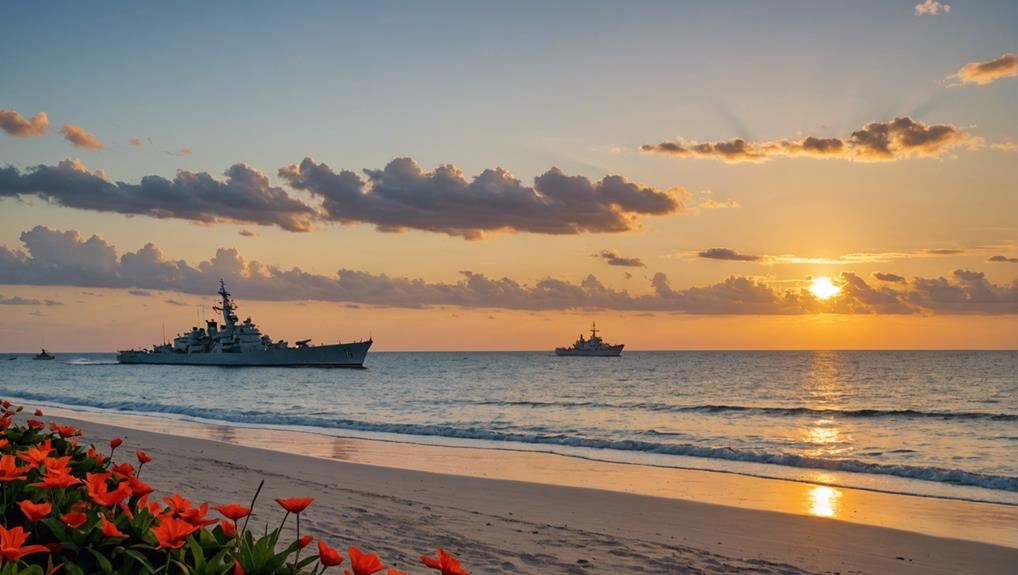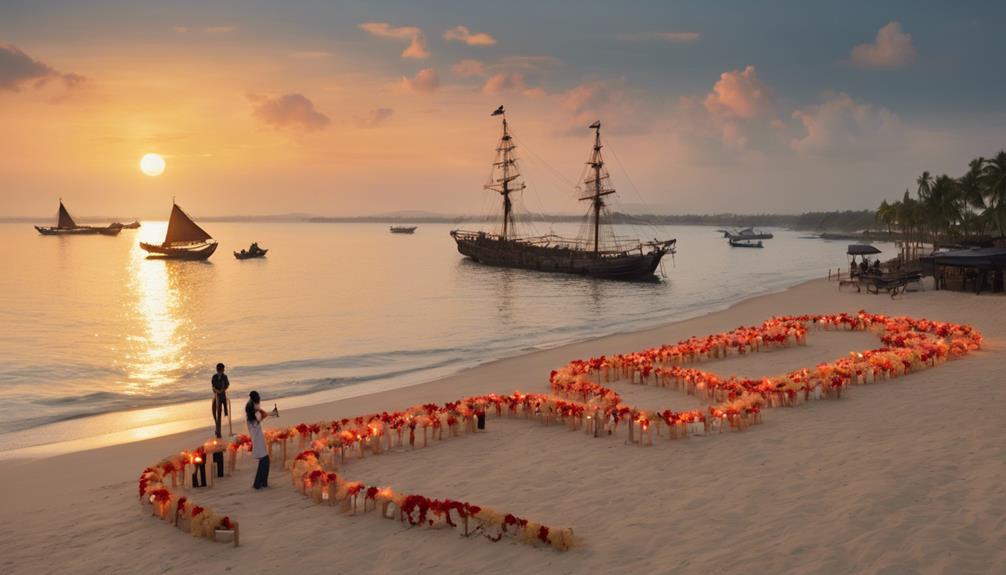Physical Address
304 North Cardinal St.
Dorchester Center, MA 02124
Physical Address
304 North Cardinal St.
Dorchester Center, MA 02124

Every year, you commemorate the anniversary of the Lingayen Gulf Landing, marking a pivotal moment in World War II. On January 9, 1945, General Walter Krueger led 68,000 GIs in a counter-offensive that was essential for regaining the Philippines from Japanese control. The battle was fierce, with Kamikaze attacks causing significant losses and strategic shifts. Activities including veteran tributes, wreath-laying ceremonies, and cultural performances help you honor the bravery and sacrifices made. This event not only reflects on past heroism but also educates about the strategic importance of Lingayen Gulf. By further engaging, you'll find new layers of historical significance waiting to be uncovered.
In December 1941, the Japanese 14th Army forcefully seized Lingayen Gulf, sparking a critical battlefront during World War II. This marked the beginning of the Japanese occupation of one of the most strategically pivotal points in the Philippines. You'd find that the American forces, under General Douglas MacArthur, were caught off guard, leading to a hasty retreat. This retreat played a pivotal role in the infamous Bataan Death March, where thousands of Filipino and American soldiers were forced to march under brutal conditions.
By January 1945, the tides of war had shifted. The Allied forces, now returning in full strength, prepared for a significant counter-offensive. You'd witness a massive naval bombardment that preceded the landing, softening up Japanese defenses along the coast. This intense preparation was critical for what came next.
On January 9, 1945, under the command of General Walter Krueger, about 68,000 GIs stormed the beaches of Lingayen Gulf. Task forces rapidly advanced, securing coastal towns and establishing a strong beachhead. This operation wasn't just about gaining ground; it was a decisive moment that marked a turning point in the Pacific theater of WWII.
The secured beachhead at Lingayen Gulf allowed the Allies to pour in more troops and supplies, steadily pushing the Japanese forces back. The events at Lingayen Gulf underscored the beginning of the end of Japanese control in the region, setting the stage for further victories in the Pacific.
The kamikaze attacks during the Lingayen Gulf invasion brought devastating losses to Allied forces. You mightn't grasp the sheer terror unless you hear the survivors' stories. These men watched as pilots, committed to their deadly mission, plunged their aircraft into Allied ships. The impact assessment of these kamikaze tactics reveals a grim reality: they weren't just suicide missions, but a calculated attempt to break the naval strategies of the Allies.
As you explore further, you'll find that the Allied defenses weren't initially prepared for such relentless assaults. The adjustment of their naval strategies was essential. They enhanced anti-aircraft defenses and improved lookout systems, yet the kamikazes kept coming, wave after wave. This relentless strategy aimed to exploit any weakness, a tribute to the desperate measures employed in the face of imminent defeat.
Listening to the survivors recount their experiences puts a human face on these harrowing statistics. Each story is a personal glimpse into the chaos and heroism of those days. These narratives not only provide poignant insights but also serve as critical historical records. They underscore the resilience and bravery required to endure such attacks and continue fighting.
This reflection on kamikaze impact isn't just about tallying losses; it's about understanding the sheer human will on both sides of the conflict. It's about appreciating the strategic shifts that occurred in real-time, under unimaginable pressure. The stories of survival and adaptation continue to resonate, reminding us of the profound costs of war and the indomitable spirit of those who lived through it.
Ship disasters during the Lingayen Gulf invasion highlight the intense and dangerous nature of naval warfare. As you explore this historic event, it's crucial to recognize the depth of sacrifice and peril faced by those at sea. The gulf, marked by fierce combat and strategic importance, witnessed several maritime disasters, each serving as a stark reminder of wartime's brutal reality.
The sinking of these vessels not only represents naval tragedies but also underscores the critical roles ships played in the broader theater of war. Here's a closer look at three significant incidents, which have since become focal points for shipwreck commemorations:
These incidents illustrate just a fraction of the challenges faced during the Lingayen Gulf invasion. Each year, these maritime disasters are remembered not just as historical footnotes but as integral parts of our collective memory, ensuring that the bravery and strategic significance of these moments are never forgotten.
Reflecting on these naval tragedies, let's now focus on the broader human cost, examining the casualties and aftermath of the Lingayen Gulf invasion. Casualty statistics from this pivotal battle are staggering, with over 150,000 Filipinos losing their lives during the conflict. The Battle for Luzon, of which Lingayen Gulf was a critical part, remains the highest net casualty battle U.S. forces fought in WWII.
As you grapple with these numbers, it's important to remember the ongoing support for those who survived. Veteran support programs have been instrumental in providing necessary aid, ensuring that survivors receive the care and recognition they deserve. These programs often include medical assistance, psychological support, and help with social reintegration.
In terms of honoring those who fell, war memorials play a significant role. These sacred sites serve as a place of reflection and remembrance, offering solace to families and comrades. Memorial services, held annually, not only commemorate the bravery and sacrifices made but also provide a platform for collective mourning and healing.
Finally, the post-war recovery process has been a tribute to the resilience and solidarity of the affected communities. Rebuilding efforts have brought renewed hope and stability, helping to mend the physical and emotional scars left by the war.
As you reflect on these aspects, it's clear that the aftermath of such conflicts extends far beyond the immediate impact, shaping lives and landscapes for generations. The commitment to remembering and supporting those affected continues to be an essential part of healing and recovery.

Let's explore the various activities planned to honor the heroes of the Lingayen Gulf Landings. This year, the commemoration is packed with events designed to both remember and educate, ensuring that the sacrifices of these veterans are never forgotten.
Firstly, veteran tributes will be a cornerstone of the ceremonies. A series of heartfelt speeches and presentations by local dignitaries and military officials will highlight the bravery and sacrifices of those who fought in the Lingayen Gulf. This will be accompanied by a wreath-laying ceremony at the Veterans Memorial Park, providing a poignant moment for reflection.
Secondly, the event will feature an array of cultural performances. These are set to include traditional dances and musical acts by local schools and community groups, celebrating the rich culture of Pangasinan while tying it back to the historic significance of the area during World War II. It's a vibrant way to connect the past with the present, engaging attendees of all ages.
Thirdly, educational exhibits will be set up throughout the venue. These displays will provide detailed insights into the strategic importance of the Lingayen Gulf Landings and the overall impact of World War II on the Philippines. They're designed to be interactive, offering visitors a chance to engage deeply with the history being commemorated.
Moreover, community engagement and volunteer opportunities will be abundant. Here's how you can get involved:
Through these activities, the community not only pays tribute to its heroes but also fosters a continued spirit of unity and remembrance.
You're wondering how locals helped during those landings? They provided essential civilian intelligence, established secret shelters, offered food provisions, medical aid, and maintained critical communication networks to support the troops effectively.
The battle caused significant ecosystem disruption, including coral damage and oil pollution. You'd also find extensive habitat destruction and numerous wildlife casualties, highlighting the severe environmental impacts of such military engagements.
You've seen Lingayen Gulf's economy flourish post-WWII with tourism growth, aquaculture expansion, and industrial development. Trade improvements and infrastructure enhancements have also greatly boosted the local economy, enhancing residents' quality of life.
You'd find Filipino guerrilla fighters essential during the invasion, engaging in guerrilla tactics, resistance strategies, sabotage operations, and intelligence gathering. They coordinated closely with Allied forces to disrupt Japanese activities effectively.
You'll find that schools incorporate the Lingayen Gulf landings into their curriculum, focusing on historical accuracy, diverse teaching methods, and student engagement to provide a thorough educational perspective on this significant event.
As you reflect on the Lingayen Gulf Landings' 79th anniversary, you'll feel a deeper appreciation for the sacrifices made. Joining the commemoration activities at Veterans Memorial Park, you'll connect with history through ceremonies and cultural performances.
Let's guarantee these heroic efforts aren't forgotten, and continue to pass on their stories. Embrace this opportunity to honor and remember those who shaped our peace and freedom. Here, history isn't just remembered; it's celebrated.